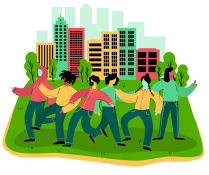
We surveyed 30 cities about trends and challenges in the past year, including how Covid-19 impacted their work.
Trends, Challenges & Covid-19 Impacts
In looking at top trends this year, we’re noticing a continued interest in park features that support daily life, including dog walking; growing, cooking or eating food; and getting some exercise on a multi-use trail. In addition, there is increasing attention on the need for parks to support inclusion, through elements like universally accessible design and Indigenous programming.
We’re also seeing a renewed interest in digital infrastructure, like free wi-fi in parks or park-based apps, which seemed to have waned during the pandemic. In 2020, 44% of cities mentioned that interest in digital infrastructure was increasing. This fell to just 26% in 2021, but has jumped back up to 48% this year.
We asked cities whether interest in the following park elements has increased, stayed about the same, or decreased over the past year.
This year, many cities are experiencing challenges around maintaining parks to a high standard, with concerns around aging infrastructure and revitalizing parks to meet changing needs at the forefront. Cities are struggling to protect and enhance biodiversity and naturalized areas in parks, while those spaces are being threatened by climate change and extreme weather events.
While acquiring and expanding parkland to meet growth needs is an increasing challenge for cities (58% in 2021, 69% in 2022), this challenge isn’t experienced evenly across the country. This year, 62% of cities indicated that this was a major challenge, 7% said it was a minor challenge, and 28% said it was not a significant challenge. In general, more urban and densely populated cities are seriously grappling with providing more green space to a growing population, while smaller cities in suburban or rural areas either still have room to grow or are already meeting their residents’ green space needs.
As municipalities move into pandemic recovery, Covid-19’s impacts on park planning, amenities, programs, operations and budgets remain at the fore. However, we’re seeing cities shift focus from meeting immediate public safety needs, toward longer term planning based on new trends and demands emerging from the pandemic. This includes expanding park maintenance, making pilot programs spurred during the pandemic permanent, and addressing the overuse of trails and natural areas through education and signage.

